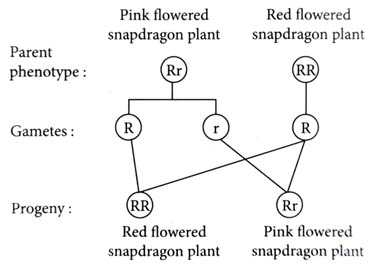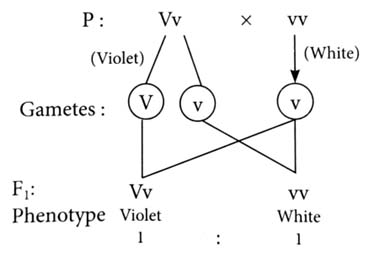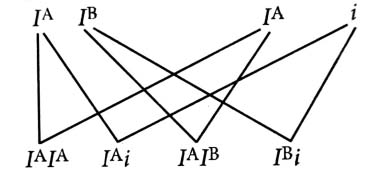As per ABO blood grouping system, the blood group of father is , mother is and child is . Their respective genotype can be [2024]
A.
B.
C.
D.
E.
Choose the most appropriate answer from the options given below.
A only
B only
C and B only
D and E only
(1)
If father has blood group 'B', mother has blood group 'A' and the child with blood group 'O' appear in progeny, this means that the parents are heterozygous.
The genotype of the father, mother and child will be and respectively.
| Parents | Father x Mother |
| Genotype | |
| Gametes | |
| Genotypes of progeny | |
| Blood groups | AB B A O |
A pink flowered snapdragon plant was crossed with a red flowered snapdragon plant. What type of phenotype/s is/are expected in the progeny? [2024]
Only red flowered plants
Red flowered as well as pink flowered plants
Only pink flowered plants
Red, pink as well as white flowered plants
(2)
When a pink flowered (Rr) snapdragon plant was crossed with a red flowered (RR) snapdragon plant then red flowered as well as pink flowered phenotypes are expected in the progeny.

In a plant, black seed color (BB/Bb) is dominant over white seed color (bb). In order to find out the genotype of the black seed plant, with which of the following genotype will you cross it? [2024]
BB
bb
Bb
BB/Bb
(2)
Test-cross is performed to determine the genotype of black seed colour (BB/Bb) plant. In a typical test-cross, plant showing dominant phenotype (BB/Bb) is crossed with the homozygous recessive parent (bb).
A heterozygous pea plant with violet flowers was crossed with homozygous pea plant with white flower. Violet is dominant over white. Which one of the following represents the expected combinations among 40 progenies formed? [2023]
30 produced violet and 10 produced white flowers
20 produced violet and 20 produced white flowers
All 40 produced violet flowers
All 40 produced white flowers
(2)
Violet is dominant over white. So, heterozygous violet flowers will have the genotype of (Vv) and white flowers will have genotype of (vv). When these two plants are crossed, the generation will have the ratio of violet : white as 1 : 1. It is shown as:

Thus, 20 violet and 20 white flowers are produced among 40 progenies.
Match List I with List II. [2024]
| List I | List II | ||
| A. | Two or more alternative forms of a gene | I. | Back cross |
| B. | Cross of progeny with homozygous recessive parent | II. | Ploidy |
| C. | Cross of progeny with any of the parents | III. | Allele |
| D. | Number of chromosome sets in plant | IV. | Test cross |
Choose the correct answer from the options given below:
A-I, B-II, C-III, D-IV
A-II, B-I, C-III, D-IV
A-III, B-IV, C-I, D-II
A-IV, B-III, C-II, D-I
(3)
Alleles are the two or more different forms of the same gene. In a typical test cross, an organism showing a dominant phenotype (and whose genotype is to be determined) is crossed with the recessive parent. The cross of an hybrid with one of the two parents is called backcross. Ploidy is the number of complete sets of chromosomes in a cell.
The production of gametes by the parents, formation of zygotes, the and plants, can be understood from a diagram called [2021]
net square
bullet square
punch square
Punnett square
(4)
The production of gametes by the parents, formation of the zygotes, the and plants can be understood from a diagram called Punnett square developed by a British geneticist, Reginald C. Punnett.
In a cross between a male and female, both heterozygous for sickle cell anaemia gene, what percentage of the progeny will be diseased? [2021]
100%
50%
75%
25%
(4)
Sickle cell anaemia is an autosomal recessive disorder.

Identify the wrong statement with reference to the gene '' that controls ABO blood groups. [2020]
The gene () has three alleles.
A person will have only two of the three alleles.
When and are present together, they express same type of sugar.
Allele does not produce any sugar
(3)
ABO blood groups are controlled by the gene . The gene has three alleles and . The alleles and produce a slightly different form of the sugar while allele does not produce any sugar. Because humans are diploid organisms, each person possesses any two of the three gene alleles. When and are present together they both express their own types of sugars, because of co-dominance.
In Antirrhinum (Snapdragon), a red flower was crossed with a white flower and in generation all pink flowers were obtained. When pink flowers were selfed, the generation showed white, red and pink flowers. Choose the incorrect statements from the following. [2019]
Law of segregation does not apply in this experiment.
This experiment does not follow the Principle of Dominance.
Pink colour in is due to incomplete dominance.
Ratio of is (red) : (pink) : (white)
(1)
Law of segregation applies in this case as when pink flowers obtained in are selfed then red and white flowers are obtained in which indicates that there is no mixing of gametes.
The genotypes of a husband and wife are and Among the blood types of their children, how many different genotypes and phenotypes are possible? [2017]
3 genotypes; 4 phenotypes
4 genotypes; 3 phenotypes
4 genotypes; 4 phenotypes
3 genotypes; 3 phenotypes
(2)
If the genotypes of husband and wife are and respectively, then the probabilities of genotypes and phenotypes among their children can be worked out as:

Genotype:
Phenotype: A A AB B
Thus, there are four possible genotypes, viz., and and three possible phenotypes, viz., A, AB and B among the children.